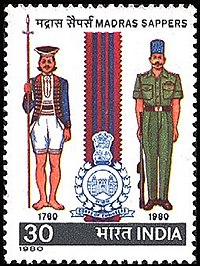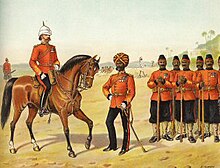Madras Engineer Group
This article includes a list of general references, but it lacks sufficient corresponding inline citations. (March 2013) |
| Madras Engineer Group | |
|---|---|
 | |
| Active | 1780–present |
| Country | |
| Branch | Indo-Pak War-1971 Kargil War |
| Battle honours | See Battle honours list |
| Commanders | |
| Colonel Comdt of Madras Sappers | Lt Gen KC Panchanathan, AVSM |
Madras Engineer Group (MEG), informally known as the Madras Sappers, is an engineer group of the
The Madras Sappers were the only regiment of the Madras Presidency Army to survive unscathed the extensive reorganisations that took place between 1862 and 1928.[1] The thambis, as the troops of the Madras Sappers are popularly known, with their hallmark Shakos have distinguished themselves in many battlefields around the world for more than 200 years.
The Bangalore torpedo, a mine clearing explosive device, was invented in the Centre at Bengaluru in the early years of the Twentieth Century.[2]
Timeline
- 1780 – Created Madras Pioneers from two company of Pioneers (On 30 September 1780 at Madras Patnam)
- 1831 – Renamed Corps of Madras Sappers and Miners
- 1834 – Relocated HQ to Bengaluru, where it remains today
- 1876 – Receive prefix Queens's Own
- 1903 – 2nd Queen's Own Madras Sappers and Miners, Renamed as part of the Kitchener Reforms
- 1911 – Renamed 2nd Queen Victoria's Own Madras Sappers and Miners
History
The second half of the eighteenth century found the
The
Since this group was constituted by the
The Madras Sappers recruited and trained small tough and wiry men from
The Madras Sappers moved into
The motto of the Madras Sappers is that common to all three regiments of the Corps of Engineers, Sarvatra (Sanskrit:Everywhere) the Indian equivalent to 'Ubique', the motto of the Royal Engineers.
Battle honours
Pre-World War I
- Carnatic (1781–82)
- Sholinghur (1781–82)
- Mysore (1792)
- Seringapatam (1799)
- Egypt 1801
- Assaye (1803)
- Java (1811)
- Nagpur (1819)
- Mehidpur (1819)
- Ava (1825)
- China (1840)
- Meanee (1843)
- Hyderabad (1843)
- Pegu (1852)
- Persia (1856–57)
- Central India (1858)
- Lucknow (1858)
- Taku Forts (1860)
- Pekin (1860)
- Abyssinia (1868)
- Afghanistan (1878–80)
- Egypt (1882)
- Tel-el-Kebir (1882)
- Suakin (1885)
- Tofrek (1885)
- Burma (1885–87)
- Chitral (1895)
- Malakand (1897)
- Tirah (1897–98)
- Punjab Frontier (1897–98)
- Boxer Rebellion (1900)
World War I
- France & Flanders (1914–15)
- Suez Canal (1915–17)
- Egypt (1915–17)
- Gaza (1917)
- Megiddo (1917)
- Sharon (1918)
- Palestine (1918)
- Baghdad (1915–18)
- Mesopotamia (1915–18)
- Tigris (1916)
- Kut-el-Amara (1917)
- India (1917)
- Persia (1918)
- N.W. Frontier (1914–15)
- East Africa (1918)
World War II
- Mersa Matruh (1940–43)
- Ngakyedauk Pass (1942–45)
- Bishenpur (1942–45)
- Meiktila (1942–45)
- Tamu Road (1942–45)
- Cassino I (1943–45)
- Abyssinia (1940–41)
- North Africa (1940–43)
- Iraq (1941)
- Syria (1941)
- Malaya (1941–42)
- Burma (1942–45)
- Italy (1943–45)
Post Independence
Symbols



The battle symbols of MEG are a sphinx to commemorate the victory in Egypt in 1801, an elephant for the victory in Assaye in 1803, a dragon for China (1848), a bighorn sheep for Zoji La (1948), and a tank for Basantar (1971).[citation needed]
Republic Day Parade
Madras Engineer Group have been actively participating in the annual Republic Day Parade of India. MEG have been awarded the Best Marching Contingent three times in 1991, 1997 and 2017.[3]
Gallery
-
Sphinx symbol depicting the campaign in Egypt, 1801.
-
Elephant emblem depicting the Battle of Assaye, 1803.
-
Dragon symbol depicting the campaign in China, during the First Opium War, 1840.
See also
- Indian Army
- Indian Army Corps of Engineers
- Bengal Engineer Group
- Bombay Engineer Group
- Madras Sappers Military Band
Notes
- ISBN 0-333-41837-9.
- ^ Duffy, Michael; Duffy, Michael, "www.firstworldwar.com", Bangalore Torpedo, retrieved 18 January 2021
- ^ "Republic Day Parade – 2017 Awards announced". Press Information Bureau, Government of India, Ministry of Defence. 28 January 2017. Retrieved 23 August 2019.
Book references
- Vibart, Henry Meredith (1881), The military history of the Madras engineers and pioneers, London: W.H. Allen & co.
External links
- https://web.archive.org/web/20091027133925/http://www.geocities.com/Athens/Acropolis/9460/remem.htm
- https://web.archive.org/web/20071108123617/http://www.regiments.org/regiments/southasia/art-eng-sig/sm-mad.htm
- https://web.archive.org/web/20090725060217/http://www.remuseum.org.uk/corpshistory/rem_corps_part10.htm
- Sify.com[dead link]
- "INDIAN PIONEER BATTALIONS". www.reubique.com. Retrieved 16 July 2021.



